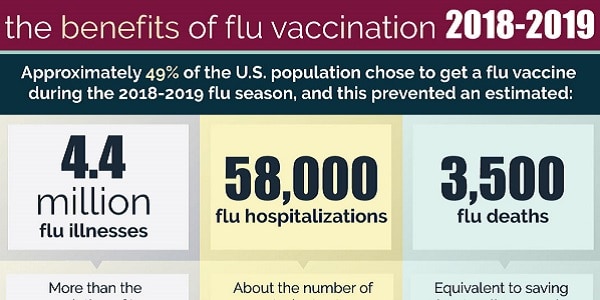Estimated Flu Illnesses, Medical Visits, Hospitalizations, and Deaths Prevented by Vaccination in the United States ... - CDC

This web page provides estimates on the burden of influenza (flu) and the effects of annual flu vaccination in the United States for the 2021–2022 season.
For more than a decade, CDC has used a model to estimate the numbers of flu illnesses, medical visits, hospitalizations, and deaths during the flu season, and to estimate the beneficial effects that flu vaccination had on illness outcomes in the United States (1-6). The methods used to calculate the estimates of flu burden prevented by flu vaccination have been described previously (1,2,6) and are outlined briefly below. CDC uses the estimates of the impact of flu vaccination to inform policy and communications promoting vaccination as the best way to prevent flu.
CDC estimates that during the 2021-2022 season, flu vaccination prevented 1.8 million flu-related illnesses, 970,000 flu-related medical visits, 22,000 flu-related hospitalizations, and 1,000 flu-related deaths (Table 1).
2021-22 Flu Burden Prevented by Vaccination
Compared with flu seasons prior to the COVID-19 pandemic, the 2021–2022 season was considered a low severity season and occurred in two waves, with more hospitalizations occurring in the second wave (7).
Despite limited influenza virus circulation, seasonal flu activity began to increase in November 2021, declined in January 2022, increased again in March 2022, and remained elevated until mid-June 2022, later than is typical. The season had predominately influenza A virus circulation with subtype A(H3N2) viruses most commonly detected (8).
CDC estimates that during the 2021-2022 season, 50% to 74% of people in the United States were vaccinated against flu. Flu vaccine effectiveness for the 2021-2022 season for all ages was 36% but varied by age group and was highest for children 6 months to 4 years (77%) and lowest among adults 50-64 years (8%) (10-11). Based on the 2021-2022 flu disease burden estimates along with vaccine coverage and vaccine effectiveness data, CDC estimates that 1.8 million flu-related illnesses, 970,000 flu-related medical visits, 23,000 flu-related hospitalizations, and 1,100 flu-related deaths were prevented by flu vaccination. The number and proportion of flu-related hospitalizations prevented by vaccination during 2021–2022 varied by age group, due to age-specific differences in flu burden, vaccine coverage, and vaccine effectiveness. Flu vaccination prevented the fewest illnesses among adults 50 to 64 years, an age group with approximately 50% vaccine coverage and for whom flu vaccine effectiveness was lowest (8%) for the most common circulating influenza A(H3N2) virus. Flu vaccination prevented the highest number of community illnesses, medically attended illnesses, hospitalizations, and deaths among children 6 months to 4 years, an age group in which vaccine uptake was moderate (67%), and vaccine effectiveness was the greatest (77%).
Annual flu vaccination is the best way to protect against flu and associated complications. Improvements in vaccine coverage could also provide great public health benefit, producing even greater reductions in illnesses and lowering demands on the health system. During flu seasons, the health care system, including outpatient clinics, emergency departments, and hospitals, can experience high patient volumes. Any reduction in flu-related medical visits and hospitalizations can reduce demands on the health care systems and improve health care providers' abilities to provide the best care. Strategies to improve flu vaccine coverage include: using patient reminder/recall systems aided by immunization information systems; expanding access to flu vaccination at pharmacies, workplaces, and schools; and organizing mobile and/or outdoor vaccination clinics.
Comments
Post a Comment